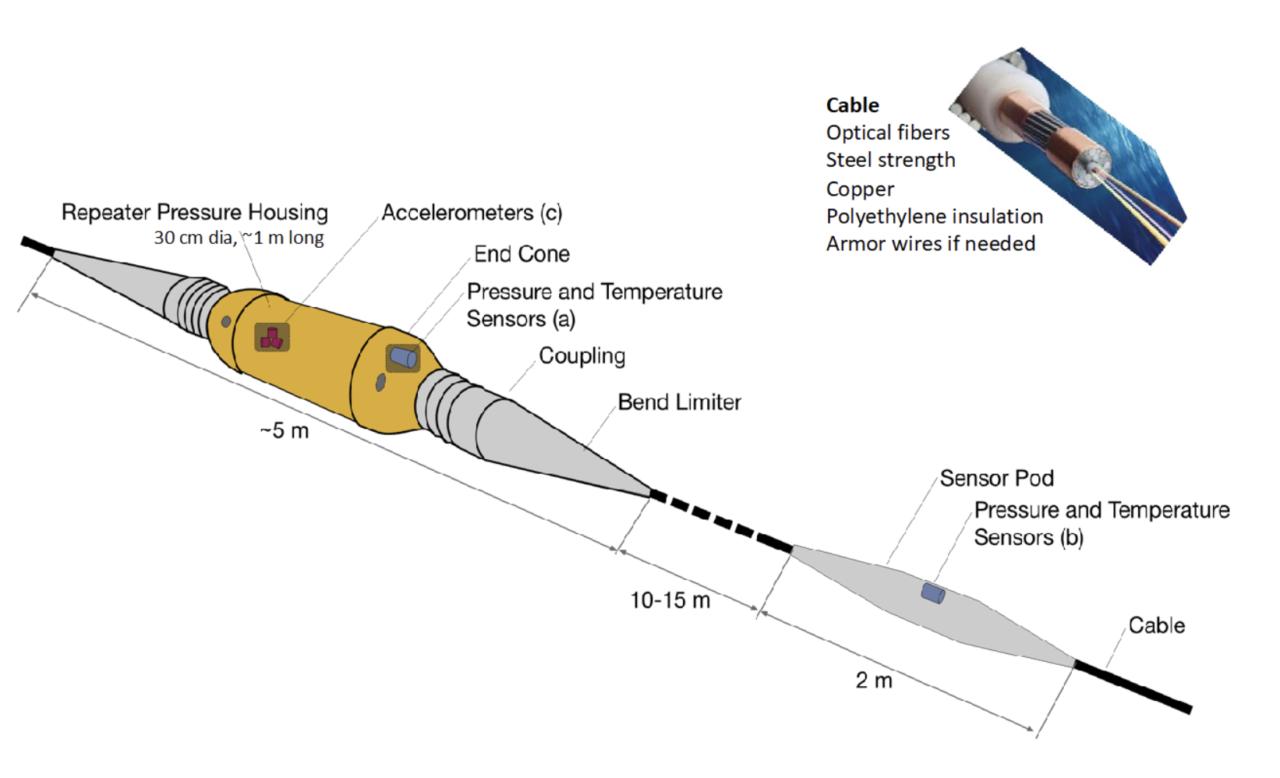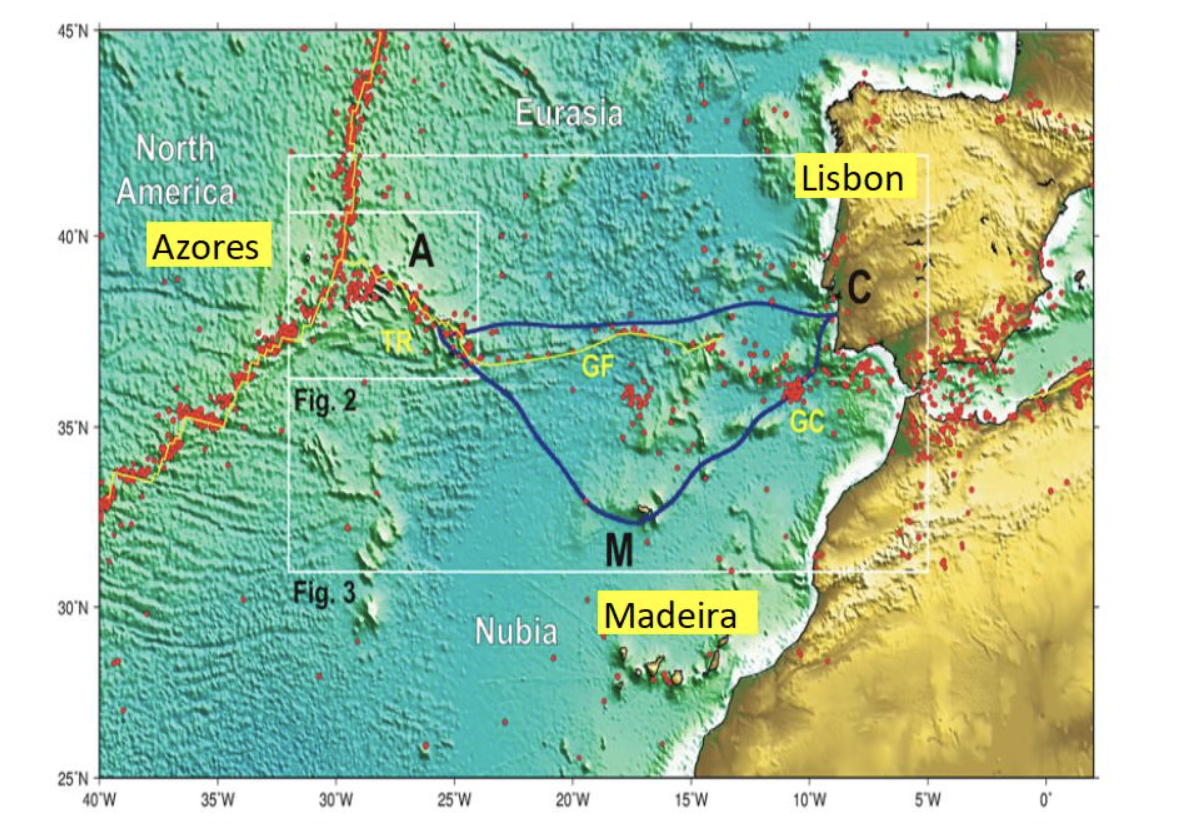Lead institution:
Joint Task Force SMART Subsea Cables – United States of America (USA)
The SMART Subsea Cables initiative seeks to revolutionize deep ocean observing by equipping transoceanic telecommunications cables with sensors to provide essential information of the state of the ocean. The sensors will use the power and communications present in the cables and will collect data on three critical environmental variables of the deep ocean:
- Temperature: characterize the changing climate with improved estimates of ocean heat content and sea level rise as relates to water’s thermal expansion;
- Ocean bottom pressure: measure ocean circulation insofar as water flows from areas of high to low pressure, track sea level rise related to melting land ice, and improve tsunami early warning via direct real-time measurement of sea surface elevation;
- Seismic acceleration: monitor seabed seismic activity to improve early warning for earthquakes, tsunamis, and volcanoes, and yield superior risk assessments for vulnerable coastal areas.
All will benefit from the cable infrastructure: sustained, real time, high reliability, long life (25 years), communication and power.

Priority Activities:
To implement telecommunication and sensing SMART subsea cable systems on a global scale, to support climate, ocean circulation, sea level monitoring, and tsunami and earthquake early warning and disaster risk reduction.

Sustainable Development Goals JTF SMART Cables will contribute to:
Goal 9 and 11: Industry, Innovation and Infrastructure, and Sustainable Cities and Communities
- Environmentally aware SMART cables simultaneously provide improved telecom connectivity plus ocean and Earth observing, via improved cable integrity/protection and resilience, while catalyzing technology development, research and innovation in developing countries.
Goal 13: Climate Action – Take urgent action to combat climate change and its impacts
- Ocean observations from SMART systems will directly contribute to the knowledge base of climate change, specifically ocean heat content, circulation, sea level rise, and tsunamis, thereby strengthening resilience and adaptive capacity to climate related hazards (coastal flooding) and natural disasters (tsunamis).
Goal 14: Life Below Water – Conserve and sustainably use the oceans
- SMART systems will contribute to knowledge and innovation for increased understanding of the ocean-climate nexus, tsunami and earthquake early warning systems, and knowledge and solutions for community resilience, and capacity development and transfer of marine technology for developing countries
Ocean Decade Outcomes JTF SMART Cables will contribute to:
Outcome 4: A predicted ocean where society understands and can respond to changing ocean conditions
- SMART cable observations of ocean bottom temperature and pressure (OBP) support shorter term operational oceanography, seasonal/El Nino scale processes, and long-term climate monitoring, leading to an improved, predicted ocean.
Outcome 5: A safe ocean where life and livelihoods are protected from ocean-related hazards.
- SMART cable measurements of OBP and seismic acceleration will directly contribute to early warning of earthquakes and tsunamis (seismic, landslide induced, meteorological). OBP on continental shelves and upper slopes will provide information on wave amplitudes, periods, and directions to local mariners and coastal populace.
Outcome 6: An accessible ocean with open and equitable access to data, information and technology and innovation.
- SMART cable infrastructure innovation – power and communication with long life on the seafloor – will enable access by other disciplines (beyond those represented by the three initial sensors) to the deep sea, and the data therefrom.
Decade Challenges JTF SMART Cables will contribute to:
Challenge 5: Enhance understanding of the ocean-climate nexus
- SMART observations of ocean bottom temperature and pressure support monitoring of the ocean portion of the atmosphere-ocean/climate/Earth system. Temperature and the ocean flow inferred by OBP gradients contribute to the ocean circulation and time/space variability of sea level, plus secular changes in tidal coefficients that affect satellite altimetric and gravity observations (and sea level) and ocean mixing (via tides, circulation, and stratification).
Challenge 6: Enhance multi-hazard early warning services
- SMART cable measurements of OBP and seismic acceleration will directly contribute to early warning of earthquakes and tsunamis (seismic, landslide induced, and meteorological). Better understanding of sea level rise will enhance informed mitigation of climate related coastal flooding and erosion, plus tidal/storm flooding exacerbated by sea level rise.
Challenge 7: Ensure a sustainable ocean observing system across all ocean basins that delivers accessible, timely, and actionable data and information to all users.
- Contribute to growing and sustaining observing systems, with, at the end of the first Decade, ~650 SMART repeaters along 45 Mm cable in service, 15 systems averaging 43 repeaters/3,000 km. After another Decade, these would grow to 2000 repeaters, 140 Mm cable, 30 systems averaging 75 repeaters/4700 km.
Decade Objectives JTF SMART Cables will contribute to:
Objective 1: Identify required knowledge for sustainable development, and increase the capacity of ocean science to deliver needed ocean data and information
SMART cables will introduce new technology that will greatly enhance and expand the existing observing system, enabling measurements of several Essential Ocean Variables (EOVs) across all ocean basins:
- Subsurface Temperature
- Ocean Bottom Pressure
The data from SMART systems will serve as the first widespread, long-term deployment of pressure sensors to better identify gaps in the ocean observing system. Measuring both ocean bottom pressure and seismic acceleration enables more accurate, broad area early warning for earthquakes and tsunamis.
Joint Task Force on SMART Subsea Cables, International Programme Office Information and visit their website: https://www.smartcables.org/
This Project is hosted by the Ocean Decade Programme Ocean Observing Co-Design – Evolving ocean observing for a sustainable future
Start Date: 01/01/2021
End Date: 31/12/2030
Lead Contact: Bruce M. Howe (bhowe@hawaii.edu)